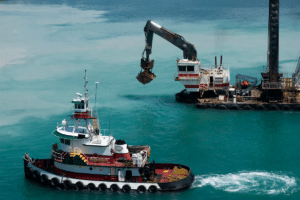Dredgers are specialized vessels used to excavate the bottoms of rivers and shallow coastal waters to make them more navigable, especially for large, deep-draft ships. Dredgers of various types gather sediments from ocean inlets, passes, and shipping channels and dispose of them in other locations. They are also used in commercial fishing. Dredgers carry and use heavy machinery, including cranes, grabbers, and buckets. Dredging equipment is, however, dangerous to work with and many seamen and other maritime workers are injured or killed in dredger accidents. While some of these accidents may not have been preventable, many were the result of a dredger’s state of unseaworthiness or negligence by the vessel’s owner or other responsible parties.

Dredgers and Dredger Accidents
Dredgers come in various types and sizes and employ different methods to excavate materials from the bottoms of waterways. Most dredgers are custom-built and fitted with machinery that sucks or digs out sediment and rocks from one place and transfers them to another, but some operators improvise by securing a standard backhoe on a pontoon and use it in dredging jobs.
The main types of dredgers include:
- Suction (vacuum) dredgers
- Bucket dredgers
- Clamshell diggers
- Backhoe/dipper type dredgers
- Water injection dredgers
- Pneumatic dredgers
- Bed levelers
- Snagboats
- Fishing dredgers
Although dredgers are usually used to keep waterways and ports in navigable condition by removing silt or deepening ship channels, they’re also used in commercial fishing. Dredges are useful in harvesting shellfish such as oysters or clams from shallow waters. In addition, some law enforcement agencies operate small dredges called drags to search for objects and bodies in rivers, lakes, canals, and other bodies of water.
Each type of dredger uses specific machinery to perform its task. Suction dredgers use long vacuum cleaner-like tubes to suck sediment out of the water and into hoppers or other devices for disposal. Bucket dredgers, in contrast, use a conveyor belt-like device linked to a series of dredgers to excavate and remove materials from the waterway bottom. Other types of dredgers use cranes with clamshell grabbers to scoop rocks, sand, and other sedimentary material from river channels, ports, and harbors.
Although this diversity makes dredging vessels useful to many maritime companies and government agencies such as the U.S. Army Corps of Engineers (USACE), the machinery they use is often unwieldy and dangerous. Crane-type dredgers are particularly dangerous due to their design, size, weight, and mode of operation. If a clamshell grabber malfunctions, any object it holds in its bucket can fall on a worker and cause crush injuries, amputations, or death.
Per an USACE document on dredging safety, dredging accidents are often catastrophic. The update reports that in a 12-month period there were seven serious accidents on contractor and USACE marine operations. In these seven accidents, three involved fatalities, two resulted in serious injuries, and two caused major property damage.
Falls and drownings are common accidents among dredge workers. In one of the incidents cited in the USACE safety update, a barge’s cook disappeared one afternoon while taking out the trash. His body was discovered downstream from where the dredging vessel was operating. The cook was not wearing a personal flotation device (PFD) because his duties behind the railing did not require him to do so.
USACE also recorded an incident in which a dredger crew member was killed when the vessel he was working on capsized while it was being anchored. In addition, a seaman failed to report to work at a dredging site even though his van was parked nearby and the gangway was in place. A search team eventually discovered his body under the gangway.
In February of 2014, a dredge worker was evacuated by first responders after he fell off the dredge Essex and onto a steel cable in the Delaware River off Delaware City. According to fire-rescue personnel, the man was taken to a local hospital with undisclosed injuries.
Types of dredger accident-related injuries include:
- Shoulder injury
- Back injury
- Post-traumatic stress disorder (PTSD)
- Amputation
- Hernias
- Eye injuries
- Crush injuries
- Knee, ankle, or leg injuries
- Hip injuries
- Head injuries
- Hand and wrist injuries
Compensation for Injured Dredger Maritime Workers
Maritime workers who are injured while working on a dredger or any vessel associated with a dredging project are entitled to seek legal compensation. The Jones Act and general maritime law give injured seamen the mechanisms to file claims against employers whose reckless negligence either contributed to the accident or caused the vessel to be unseaworthy.